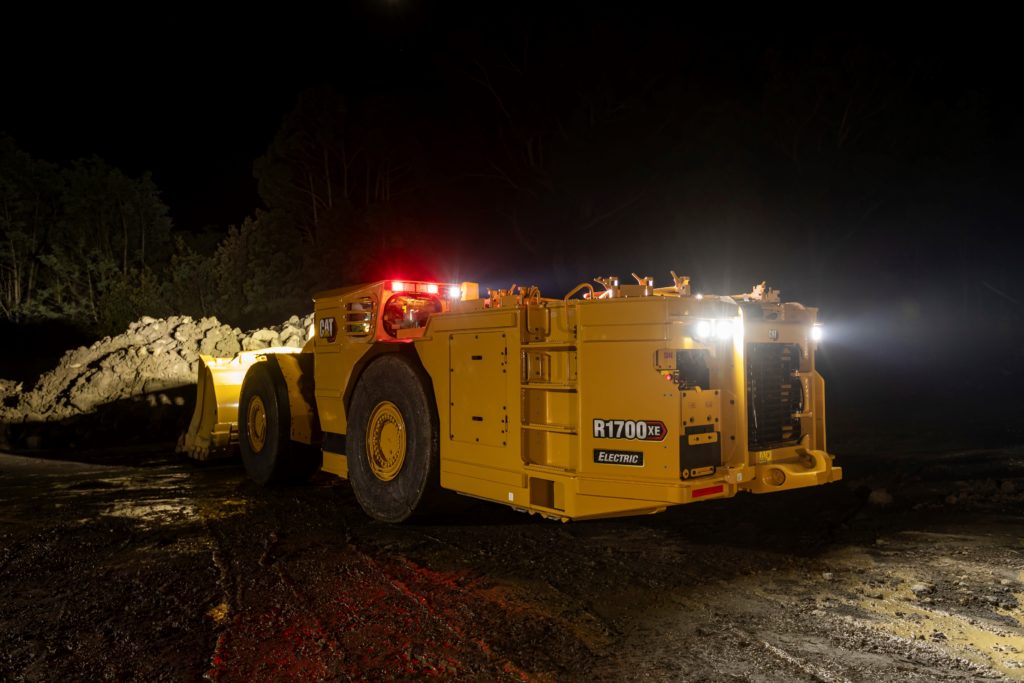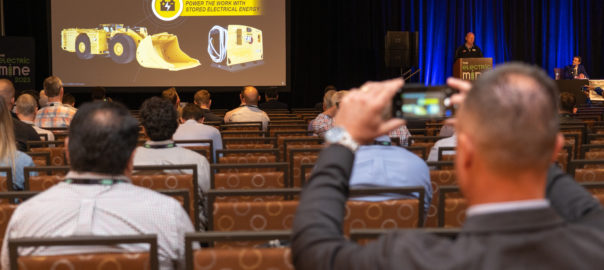The first field follow trial of Caterpillar’s R1700 XE battery-electric loader has been deemed a success by one Glencore trial participant, with the machine anticipated to surpass the productivity performance of the equivalent diesel LHD running at Glencore’s Nickel Rim South mine, in Sudbury, Canada.
Speaking in a video, Paul Kant, Glencore’s Maintenance General Foreman at the mine, said the battery-electric loader was likely to outperform the diesel-powered Cat® R1700G it was being benchmarked against at the operation over the trial period.
The mine has been using the machine, a 15-t payload loader, as part of ongoing plans to incorporate new technology at its Sudbury Integrated Nickel Operations. This includes the development of an all-electric equipment fleet at the Onaping Depth project.
The Sudbury Integrated Nickel Operations have played a significant role in the development of the R1700 XE, hosting a proof-of-concept trial of a battery-electric R1300 LHD at one of the mines where the machine ran in trials alongside its diesel equivalent. Caterpillar used the insight gained from this testing to develop the commercial R1700 XE.
The R1700 XE is rated with a 24,190 kg lift and tilt breakout, and, according to Caterpillar, features a battery-electric design that delivers superior productivity in underground applications with the benefits of minimal heat and no engine exhaust emissions. It offers an 18 km/h top speed.
It is designed to work with the Cat MEC500 Mobile Equipment Charger, a 1,656 kg (2,037 kg with optional skid) portable charger that, Caterpillar says, eliminates the need for regular battery handling and swapping, allowing for more efficient charging and production. The MEC500 offers a 500 kW capability at a range of 300-1,000 V and up to 700 Amps. The adjustable output can be used to trickle charge or quickly charge the R1700 XE – with a single unit delivering a full charge to the R1700 XE in less than 30 minutes or two units in parallel achieving this in less than 20 minutes.
The R1700 XE in Sudbury, working alongside either one or two MEC500s, has clocked more than 11,000 machine hours. During initial test operations, the customer indicated a circa-320,000 kg reduction of CO2 emissions and displayed a more than 10% improvement in speed on grade.

Speaking at The Electric Mine 2023 conference in Tucson, Arizona, in May, David Rea, VP and General Manager, Caterpillar Inc (pictured at the top), said of the machine: “We’re delivering for our customers improvements in safety, cost, productivity and sustainability.”
Machine availability in these field-follow trials has been helped by an up to 150-minute run time between charges and an average 18.5-minute charge rate with the dual chargers.
According to Glencore, the machines Caterpillar has put out in the field to date have also exhibited lower energy consumption compared with the diesel equivalent – more than 10%, in fact. And, while trials to date have all been in manual mode, Rea said the R1700 XE units in the field could be equipped for teleremote operation and were also “factory ready” for Caterpillar’s fully autonomous loading system.
Operations are being facilitated thanks to some “800 channels of machine data” flowing off the machines to those supporting the loaders, Rea said. This has allowed personnel from Caterpillar and Cat dealers to diagnose problems in the field and optimise the machine’s charging and operating strategies.
While Caterpillar continues to clock up the operating machine hours for its R1700 XE, it is also in the process of developing its first battery-electric truck.
“We’re not just stopping at the loader; we also need a truck to go alongside that loader,” Rea said in Tucson, adding that this would be a three-pass match for the R1700 XE – therefore, a truck boasting at least a 45-t payload.
Rea confirmed the new truck would be charged by the MEC500, but the company was working on both a fast charge and battery swap option for the vehicle.
“Our alliance with Newmont is leading the development of this truck,” Rea said, referencing a strategic alliance Caterpillar and Newmont announced in 2021 to deliver “26 first-of-a-kind battery-electric autonomous vehicles in both an underground and open pit operation by 2027”.
This agreement involves the introduction of these vehicles to Cripple Creek and Victor (open pit) and Tanami (underground) in USA and Australia, respectively.
“The first deployment of this [battery-electric] truck will be at Newmont Tanami,” Rea confirmed at the event.








